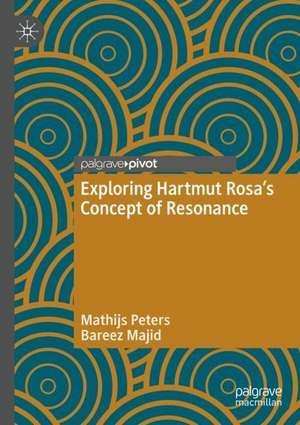Exploring Hartmut Rosa's Concept of Resonance
Autor Mathijs Peters, Bareez Majiden Limba Engleză Hardback – 2 ian 2023
The concept of resonance was first introduced by Hartmut Rosa to foreground the importance of affective, emotional, transformative and uncontrollable experiences in socio-political contexts that he characterizes as alienating. Based on a critical reading of Rosa’s theory and further developed through engagement with Theodor W. Adorno, Gilles Deleuze, Hannah Arendt, Judith Butler and others, this book introduces the notion of a ‘spectrum of resonance’ which encompasses both critical resonance and affirmationist resonance. This spectrum of resonance is used to analyse various forms of aesthetic experience illustrated with reference to Edgar Reitz’s film Heimat and the music of Nick Cave and Kayhan Kalhor.
The spectrum is also deployed in the fields of museum, memory and trauma studies to show how experiences of resonance contribute to the constitution of political and social identities. The focus here is on memory practices in the Kurdistan Region of Iraq and the book seeks to decolonize resonance theory.
Preț: 352.80 lei
Nou
Puncte Express: 529
Preț estimativ în valută:
67.51€ • 70.63$ • 56.08£
67.51€ • 70.63$ • 56.08£
Carte tipărită la comandă
Livrare economică 03-17 aprilie
Preluare comenzi: 021 569.72.76
Specificații
ISBN-13: 9783031180590
ISBN-10: 3031180593
Pagini: 167
Ilustrații: XI, 167 p. 5 illus.
Dimensiuni: 148 x 210 x 18 mm
Greutate: 0.37 kg
Ediția:1st ed. 2022
Editura: Springer International Publishing
Colecția Palgrave Macmillan
Locul publicării:Cham, Switzerland
ISBN-10: 3031180593
Pagini: 167
Ilustrații: XI, 167 p. 5 illus.
Dimensiuni: 148 x 210 x 18 mm
Greutate: 0.37 kg
Ediția:1st ed. 2022
Editura: Springer International Publishing
Colecția Palgrave Macmillan
Locul publicării:Cham, Switzerland
Cuprins
1. Introduction: Moments of Resonance.- 2. Defining, Critiquing, Defending and Revising Resonance.- 3. Towards a Spectrum of Resonance.- 4. Resonance and Aesthetic Experience: Between Critique and Postcritique.- 5. The Spectrum of Resonance and Edgard Reitz’s Heimat.- 6. The Spectrum of Resonance and Amna Suraka.- 7. Conclusion: A Resonant Turn?
Notă biografică
Mathijs Peters is a lecturer at the Leiden University Centre for the Arts in Society, The Netherlands.
Bareez Majid is a postdoctoral research fellow at the Heidelberg Centre for Transcultural Studies, Germany.
Bareez Majid is a postdoctoral research fellow at the Heidelberg Centre for Transcultural Studies, Germany.
Textul de pe ultima copertă
This book makes a compelling case for utilising experiences of resonance in various academic and societal fields.
The concept of resonance was first introduced by Hartmut Rosa to foreground the importance of affective, emotional, transformative and uncontrollable experiences in socio-political contexts that he characterizes as alienating. Based on a critical reading of Rosa’s theory and further developed through engagement with Theodor W. Adorno, Gilles Deleuze, Hannah Arendt, Judith Butler and others, this book introduces the notion of a ‘spectrum of resonance’ which encompasses both critical resonance and affirmationist resonance. This spectrum of resonance is used to analyse various forms of aesthetic experience illustrated with reference to Edgar Reitz’s film Heimat and the music of Nick Cave and Kayhan Kalhor.
The spectrum is also deployed in the fields of museum, memory and trauma studies to showhow experiences of resonance contribute to the constitution of political and social identities. The focus here is on memory practices in the Kurdistan Region of Iraq and the book seeks to decolonize resonance theory.
The concept of resonance was first introduced by Hartmut Rosa to foreground the importance of affective, emotional, transformative and uncontrollable experiences in socio-political contexts that he characterizes as alienating. Based on a critical reading of Rosa’s theory and further developed through engagement with Theodor W. Adorno, Gilles Deleuze, Hannah Arendt, Judith Butler and others, this book introduces the notion of a ‘spectrum of resonance’ which encompasses both critical resonance and affirmationist resonance. This spectrum of resonance is used to analyse various forms of aesthetic experience illustrated with reference to Edgar Reitz’s film Heimat and the music of Nick Cave and Kayhan Kalhor.
The spectrum is also deployed in the fields of museum, memory and trauma studies to showhow experiences of resonance contribute to the constitution of political and social identities. The focus here is on memory practices in the Kurdistan Region of Iraq and the book seeks to decolonize resonance theory.
Mathijs Peters is a lecturer at the Leiden University Centre for the Arts in Society, The Netherlands.
Bareez Majid is a postdoctoral research fellow at the Heidelberg Centre for Transcultural Studies, Germany.
Caracteristici
Presents various critical explorations of the concept of resonance, as originally developed by Hartmut Rosa Foregrounds the value of affective, emotional, transformative and uncontrollable experiences of resonance Embeds the concept of resonance in philosophy, Critical Theory, postcritique, memory studies and postcolonialism
